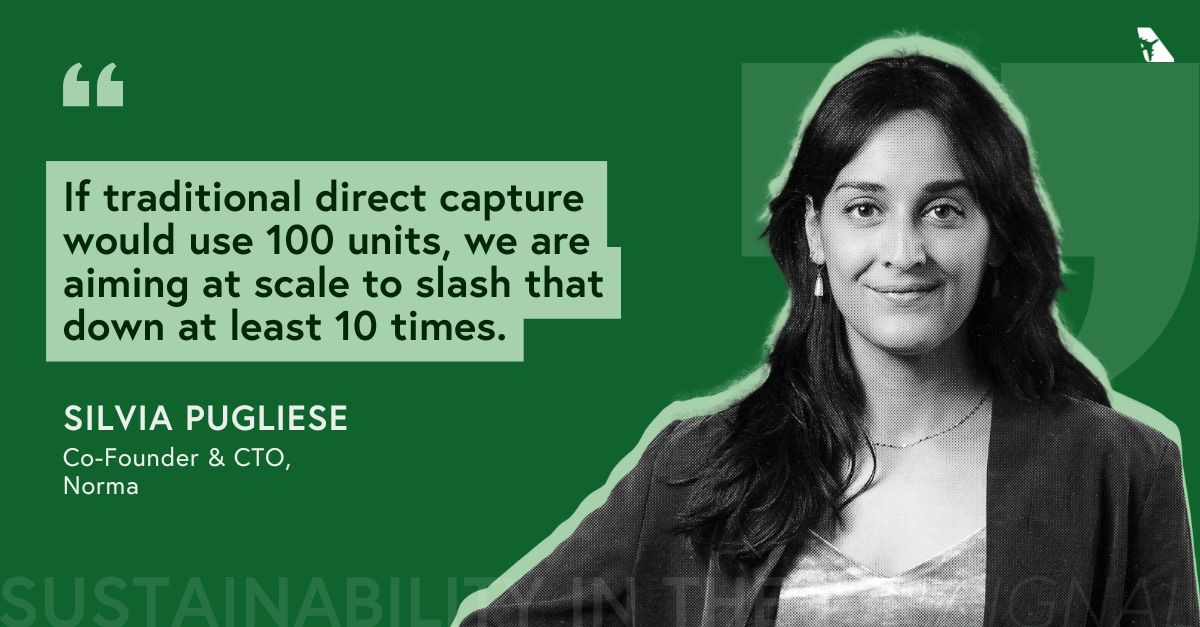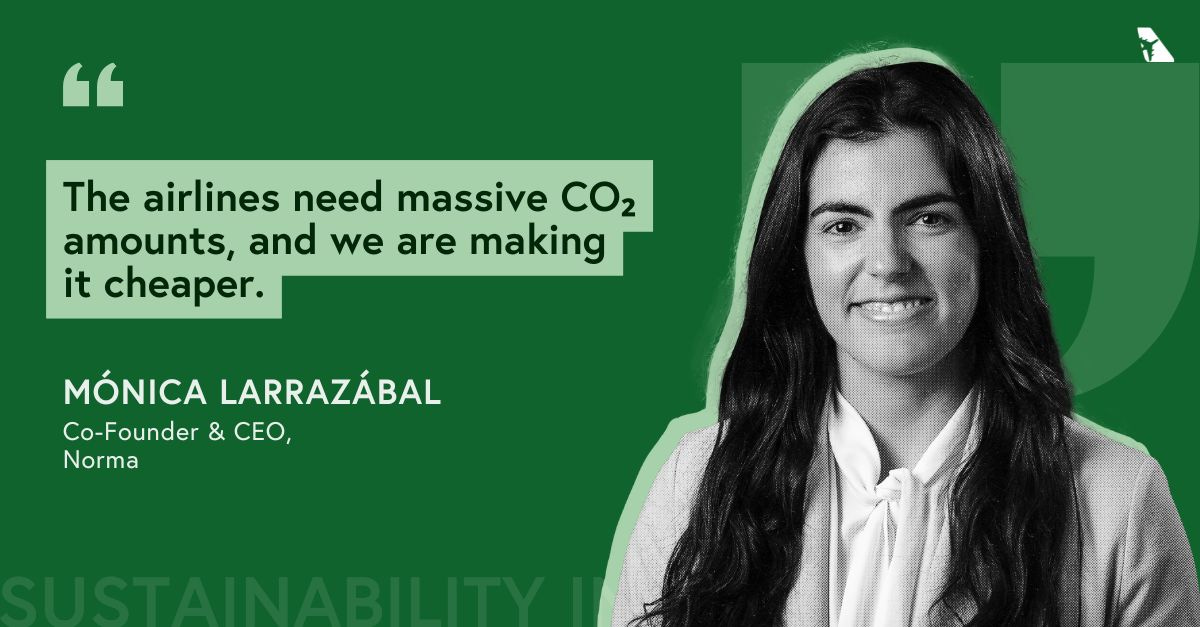How Norma's radical energy-reuse approach could make DAC affordable for aviation
In this episode, we speak with Silvia Pugliese and Monica Larrazabal, the co-founders of Norma.
We’re excited to introduce Signal, a new series within our Sustainability in the Air podcast that shines a light on the startups shaping the future of aviation and climate innovation. Signal is hosted by Dirk Singer, Head of Sustainability at SimpliFlying, who has long tracked the early signs of change across the sector.
In this inaugural episode, Dirk speaks with Silvia Pugliese and Monica Larrazabal, the co-founders of Norma, a direct air capture (DAC) startup tackling one of the industry’s toughest challenges: its sky-high energy demands. Together, they discuss Norma’s breakthrough approach to reusing energy within the capture process, their vision for modular, scalable DAC, and what this could mean for aviation’s carbon removal future.
Here are the key highlights of the conversation:
Tackling the DAC energy challenge with supercapacitors (4:30)
From batteries to hybrid devices: how the tech works (6:39)
Modularity and the “box” approach to capturing CO2 (8:22)
The founders’ origin story and vision (10:24)
Cost targets and the $100 per ton debate (16:39)
Female founders in climate tech: challenges and opportunities (22:21)
DAC and airlines: CO2 for e-fuels and decarbonization choices (32:04)
Competing (or not) with Climeworks (38:05)
Scaling well versus scaling fast: Norma’s roadmap (43:21)
Looking to 2030 and beyond (46:14)
Keep reading for a detailed overview of the episode.
Every million molecules of air contains just 420 molecules of CO2. Capturing that carbon dioxide and concentrating it into pure form requires enough clean electricity to power an average US home for 2-3 months per tonne removed.
This is the energy paradox at the heart of direct air capture: the cure threatens to be as energy-intensive as the disease it’s trying to solve.
Silvia Pugliese and Monica Larrazabal believe they’ve cracked this fundamental challenge by treating DAC not as an energy-consuming process, but as an energy-storing one.
“We figured out how to reuse most of the energy for the process,” explains Silvia Pugliese, Norma’s CTO and a chemistry PhD. “We managed to get two birds with one stone by capturing CO2 and reusing the energy that we spent during the process.”
Their breakthrough came from an unexpected source: a technology most of us use without realising it.
Supercapacitors, the energy storage devices that make rapid phone charging possible, inspired their approach. Pugliese saw that both DAC and supercapacitors rely on moving ions back and forth in a liquid. If the same cycles that store and release energy in supercapacitors could be applied to CO2, perhaps the system could capture carbon while recycling its own power?
The potential impact is staggering. Where current DAC systems typically consume 1,500-3,000 kWh per tonne of CO2 captured, Norma’s approach targets a 10-fold reduction. That is a revolutionary prospect for an industry that has faced constant criticism for its high energy demands.
Breaking the industrial model
Norma’s approach enables a completely different deployment strategy. Instead of building massive industrial facilities like many current DAC companies, their technology comes in modular units, “boxes around half the size of your desk,” as Pugliese describes them.
Each unit can capture CO2 while storing and releasing energy independently, and multiple units can be connected to scale capacity up or down as needed.
This modular architecture leverages existing manufacturing capabilities. Because supercapacitor components are already used across sectors like energy, transportation and consumer electronics, Norma benefits from well-established supply chains and deep global talent pools.
This approach puts them in company with a new generation of DAC innovators rethinking the industry’s fundamental assumptions. Irish company NEG8 Carbon, for example, targets low costs through low-temperature processes. Israeli startup RepAir claims its electrochemical approach uses just one-quarter the energy of current technologies. Dutch company Carbyon is betting on modular manufacturing to achieve consumer electronics-scale production.
This wave of innovation represents a maturation of the DAC sector, which has learned hard lessons about over-promising. “The DAC industry does have a history of over-promising a little bit,” Larrazabal acknowledges. “You know, we’ve seen countless examples of ‘yes, we can get to $70 per tonne,’ or ‘we will have megatons by this year, gigatons in 2030.’”
Conservative ambition
Despite having “very exciting projections in our Excel files,” as Larrazabal puts it, Norma takes a deliberately cautious approach to public claims.
“We want to be cautious of how we treat that excitement. We think if we just give the headline that our technology can get to $80 per tonne, it doesn’t help the sector because there’s a lot of work to get there.”
That work spans laboratory optimisation, engineering challenges, and manufacturing scale-up. But early signs are promising. Norma has secured MilkyWire as an early client and has successfully raised funding with backing from Counteract, demonstrating market validation for their approach.
The aviation industry represents a particularly compelling market. Airlines are looking into both sustainable aviation fuels and carbon removals, with both options constrained by high costs. The industry’s CO2 appetite is enormous; global aviation emits nearly one billion tonnes annually.
Larrazabal brings relevant experience to this challenge, having completed her MBA internship at Heirloom, one of the most high-profile US DAC companies. “I learned that this is a moonshot and you need to think big,” she says. “That’s why we’re not doing incremental changes, but building something radically different from scratch.”
The 2035 vision
Looking toward 2035, Norma envisions a world where atmospheric CO2 capture has become routine infrastructure. “If successful by 2035, Norma’s technology will create a new standard for the industry,” says Larrazabal. “Maybe CO2 from Norma will run airports at many places around the world.”
The pathway follows a clear timeline: demonstration projects proving economics by 2030, followed by massive deployment reaching megatonne scale in the following decade. But this vision extends beyond just technology adoption.
“Today we are the only fully female co-founding team in the direct air capture startups that exist in 2025,” Larrazabal notes. “Hopefully by 2035 we’ve made this more normal and there are many more fully female co-founding teams creating moonshots for important things like climate change.”
Whether Norma’s energy recovery approach will achieve its ambitious efficiency targets remains to be seen. But their combination of breakthrough technology, industry experience, and measured ambition represents the kind of mature innovation the DAC sector needs to fulfil its climate potential.
As the industry learned from its early hype cycles, it isn’t whether someone can make DAC work; the pioneers proved that. The question is whether new approaches can make it work at the scale and cost that climate goals demand.




